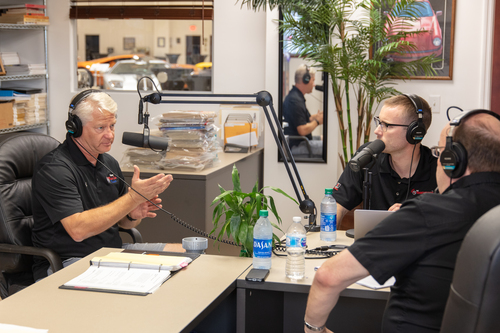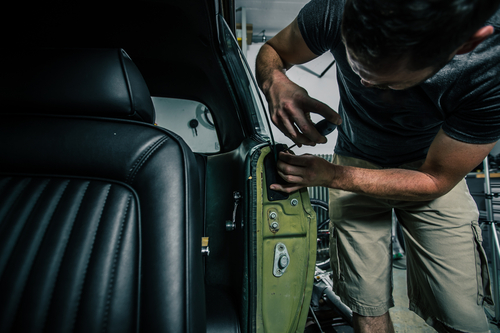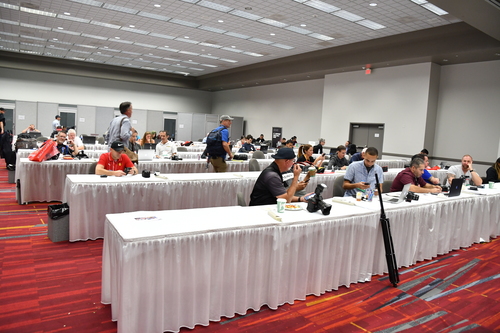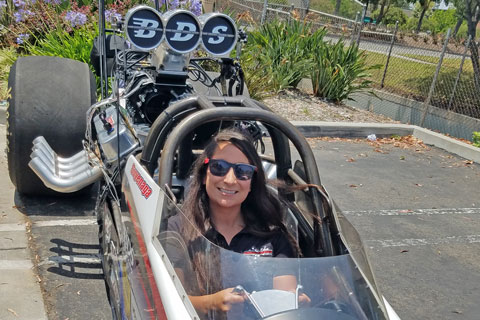PEOPLE
Social-Media Influencers Revisited
Did the COVID-19 Pandemic Just Advance the Playbook?
By Mike Imlay

John Kraman (right) interview Ed Dedick, operations and
restorations manager for the American Muscle Car Museum.
Avery believes that partnering with podcasters can be an
effective and affordable strategy for brands in search of
authentic connections with social-media consumers.
In the early months of the pandemic, as state after state began to lock down, SEMA News examined the advantages that social-media content creators (aka “influencers”) could bring to enthusiast and consumer engagement. Our article entitled “The New Media Landscape” asked: “Can tapping social-media influencers promote business recovery?”
The answer, it turns out, was unequivocally yes.
Throughout the pandemic, industry content creators saw record traffic. Aftermarket businesses of all shapes and sizes amplified their voices, and well-timed social-media marketing initiatives helped fuel aftermarket growth, even as other American business sectors faltered. Now, with the economy reopening, SEMA News revisits the topic to explore how the past year’s experience has advanced the social-media marketing playbook.
By now, virtually everyone is familiar with the concept of “social-media influencers.” While the term has become a catchall for social-media personalities with large followings, many of them in the automotive realm wince at the title. Some prefer to be called “brand ambassadors,” but the safest description is probably “content producers.”
Whether through Instagram, YouTube, podcasting or other social-media platforms, they create regular photos, posts, videos and productions (typically around a single theme) intended to inform and entertain fellow enthusiasts. Most create that content in a freewheeling freelance environment, often first as a hobby that grows organically to such an extent that they eventually monetize it.
Authentic Messaging
“I think a couple of the big advantages that brands have working with social-media content creators and influencers is that they get a very genuine and authentic message delivered to an audience,” said Derek Drake, CEO of DriveShop, a Redmond, Washington-based marketing agency specializing in social-media channels.
According to Drake, there are other key benefits: Campaigns are highly scalable based on goals and budgets. Brands can easily target messaging to niche or broader audiences. What’s more, social-media content has a long lifespan, and brands can even repurpose content created by an influencer through the brand’s own social channels.
“All of that makes social-media marketing really effective,” Drake said. “It is a very affordable way for brands to get a high volume of content out about their products, their company and what they’re doing in the industry, instead of having to pay production companies, crews and agencies to produce all that content.”
During COVID-19’s onset in March 2020, DriveShop launched research into content creators, their engagement with followers, and their collaborations with sponsors and advertisers. The survey showed that roughly half of influencers had already increased their follower numbers, and a third of the influencers were posting more frequently to meet the growing demand for content. Most importantly, 52% saw a surge in follower engagement and interaction with what they posted, even while only 22% said that they were posting content specifically related to the pandemic.
If anything, the ensuing months proved the innate value of social-media marketing and further solidified the aftermarket’s relationship with content creators.
“There are definitely some broad-stroke changes that happened,” Drake observed. “I wouldn’t call them necessarily huge shifts in the way influencers, brands and audiences are working but more of an acceleration of the trends we were seeing before the pandemic.
“The volume of partnerships that are coming out of different initiatives and programs and campaigns is increasing quite a bit. We’re also seeing quite a lot of new brands that haven’t necessarily done influencer and social-media marketing before coming to the table and asking, ‘How do I get engaged with an influencer to help tell the story of my company or my brand or the story of the product I’m bringing to market?’ So we’ve definitely seen an increase in the engagement and participation of manufacturers and brands over the last six to nine months—especially in the aftermarket space.”

enthusiasm for social-media content that reflects the rush of
live, up-close automotive excitement. Although a shift in
tone, the phenomenon will offer further opportunities for
brands to connect with influencers and their audiences.
Photo courtesy: Erik Cox Photography/Shutterstock.com
As Seen on YouTube
When SEMA News interviewed automotive YouTuber Rob Dahm in April 2020, his subscribers numbered close to 800,000. During the pandemic, that number grew to 893,000. Perhaps even more important, his channel’s average viewer watch time—a highly prized YouTube metric—dramatically increased.
“It’s been a grind but a consistent grind, and that’s a good thing,” he said of his work over the past year. “I think that the pandemic in many ways has solidified YouTube and online media as sources of information.”
Dahm’s video content includes build projects, product demonstrations, visits to garages and manufacturing facilities, and interviews with brand representatives. His latest vehicle project has been a four-rotor, all-wheel-drive Mazda RX-7, which he recently raced against a Subaru WRX STI driven by Travis Pastrana.
“I was racing an industry legend, and I almost beat him,” Dahm mused. “That was a testament to all of the different products and people that gave me advice. Some of the biggest names in the industry guided me. For me to run a tube-chassis car, not being an automotive engineer, and to competitively race a 1,400hp vehicle—that says something about the way the community comes together.”
That sense of community resonated with his subscribers, who turned to him for inspiration to tackle their own automotive projects during the lockdowns. Now that stay-at-home orders have diminished, his viewership is sticking with him.
“At this point, there are people who have started car projects,” he said. “As we all know, not all of them get finished, but they still make progress on them on average. So from a consumer standpoint, I definitely see interest levels up and more parts being purchased, and that’s not fading or going away. That’s a very exciting, positive part [of the last year]. There are a lot of people taking on more complex projects because either they have the time or it’s a source of happiness and escape for them.”
However, Dahm said that his subscribers are also expressing interest in live automotive gatherings as the nation reopens for business. To meet that growing demand, Dahm has begun presenting visits to private industry events staged in very controlled environments.
“People are just so ready to continue living their lives,” he said of his audience. “They want to see somebody doing something out there. The car world is definitely filled with a lot of very energetic people filled with that entrepreneurial spirit. People want to get out there even with [some degree of] risk to themselves. They just want to experience life and that rush. I mean, the whole point of automotive is the rush of the drive, which has taken a toll.”
That thirst for event-related content has also helped Dahm further solidify his relationships with industry brands and sponsors. Here, Dahm strives for authenticity. If he doesn’t personally believe in a brand or use its products, he won’t endorse them in his videos.
“I don’t go out looking for sponsors, and never once have I messaged companies asking for something. They message me,” he said. “In these relationships, I’m not looking for what they can give me. My job is focused on what’s interesting, on where the story is, because the more interesting the video and title are, that’s the benefit for me. There are many people out there whose stories I just love sharing. They’re interesting people, and their products are great, and they themselves are memorable.”
Still, Dahm said it’s impossible not to take note of the rising compensation rates he and many YouTubers are seeing, thanks to recent spikes in viewership.
“It’s a very interesting realm to be in, and I think it blows some people’s minds the amount of money being spent on YouTube,” he observed. “For a typical video, you’re talking about $4,000–$6,000 of [product compensation] or cash for a mention or sponsorship-type of role. For smaller companies, that’s a real eye-opener, understandably, and for them, it’s probably not worth it. But that’s what is being paid right now, and as that number has grown, the number of people willing to pay it has also grown.”

put their hands to work throughout the pandemic, often
turning to social- media content creators for inspiration, tips
and brand recommendations for their do-it-yourself projects.
Content consumption surged, and aftermarket sales did
likewise. Photo courtesy: Shutterstock.com
Podcasts and Pitches
Of course, when seeking to partner with content creators, there are many platform options, ranging from Instagram to Facebook to TikTok. Sometimes overlooked in the conversation is podcasting, which Mecum Auctions Executive Producer Matt Avery said can be an especially affordable channel for smaller brands.
Avery co-hosts the “Mecum On the Move” podcast along with Mecum Auctions Director of Company Relations John Kraman. Launched in the spring of 2020, the podcast covers Mecum Auctions news along with in-depth industry interviews touching a full range of performance and classic-car topics. It is considered one of the fastest-growing automotive podcasts in a progressively hot medium.
“When you have a marketing budget and you’re looking at the best use of your dollars, podcasting is very accessible,” Avery noted. “It can be a great way to reach a targeted audience.
“The nice thing about a podcast is that for great content, the sky is the limit in terms of who you can connect with, the brands that you can connect with, and the enthusiasm you can connect with. The technology is accessible. It’s not too hard to get set up with a platform to host, and it’s not too hard to get the gear to do it. The problem is being able to produce it regularly, because, really, that’s the way to dial in your audience.”
Which means that there are plenty of podcasters constantly on the lookout for interesting items and guests to highlight—and, therefore, highly receptive to company news items, new-product announcements and other inside scoops from brands. Additionally, brands often leverage podcasts through radio-like 30-sec. ad buys and segment or episode sponsorships. But Avery says an ideal way to engage is to offer a company spokesperson as a guest
expert on a topic of interest.
“The key as a brand is to remember that it is audio,” Avery said. “Unfortunately, audio can reveal a speaker’s flaws if you have someone who is unfamiliar with the platform or who doesn’t really understand it, and nothing will irritate a podcast host like a guest who rambles on.”
Like YouTube channels, podcasts have surged in popularity over the past year and are ubiquitous across a variety of platforms that include Apple Podcasts, Google Podcasts, Spotify and Stitcher, to name a few. Pitching a podcaster starts with an e-mail press release, which in today’s shifting media landscape has evolved into something more dynamic and interactive than in olden times.
“As a journalist and a podcaster, what I’m looking for in a press release is good information, good tech, but I also want high-resolution imagery,” Avery said. “To be innovative, you could include an audio message that’s recorded professionally or tee up a podcast soundbite to drop into the show.
“Audio files are small and very easy to attach. It’s no different from supplying B-roll of a brand-new vehicle or highlight photography. That way, you’re giving podcasters no excuse not to use that content.”
According to Avery, audio from a company owner or manager who explains a new product or commentary from the people who design, build or install it is podcast gold that will easily grab the attention of a host or a producer. If the image and audio attachments are too large for email, a link to an easily downloadable file is essential.
“Again, the more streamlined you make it, the better, so if you’re marketing a new product, event, or whatever you want to promote, make it turnkey,” he said.
Connecting With Influencers
While marketing through social-media influencers can seem pricey in some cases, it’s far from a Goliaths-only game. In fact, working with content creators is a great way for smaller companies to level the playing field and get their messages out. The crucial task is finding content creators who resonate with your brand and trusting them to deliver your message to their audiences in their own, authentic manner.
“A great way for a company to get started is to look within their own customer base,” Drake suggested. “Look to see who is using the product and has a presence on social media. Start to work with them and say, ‘Hey, can you give us some testimonials? Could we give you a new product to try?’ Those types of engagements—the genuine, authentic engagements that you have with existing customers—would be key.”
According to Drake, another step would be to simply search social-media channels for influencers who are creating content that aligns with your brand, products and interests. Engage them and make them customers first and then advocates for your brand.
“Now, I caveat that by saying that the brand doing this needs to have a presence on social media,” he said. “You have to be on Instagram, Twitter and Facebook so you can interact with people, but if you’ve got that, then I would start with your core customers.”
Meanwhile, aftermarket brands of all sizes are already benefiting from a pilot SEMA Social Media Correspondents program launched in partnership with DriveShop a few years ago. The initiative basically credentials influencers much like other media professionals at various SEMA events—notably the SEMA Show, the annual Motorsports Parts Manufacturers Council’s Media Trade Conference and, more recently, the SEMA360 online trade event. In exchange for that special access, influencers agree to generate exclusive social-media content that highlights SEMA-member companies and products.
“We initially launched the program a few years ago at the SEMA Show with the intent to create awareness and bring attention to our industry, member products, and the innovative ideas that are born out of the Show,” explained Ira Gabriel, SEMA vice president of marketing, public relations and communications. “The program has since grown to encompass more than 80 influencers on many different platforms from all around the country and representing different segments—truck, off-road, sport compacts, hot rods, racing and so forth. It’s oriented through the lens of young builder-influencers and what they experience through SEMA. We ask the influencers to focus on the products they discover and use, how they use them, and their enjoyment of the industry, because it’s all about trying to create awareness for association members.”
According to Gabriel, the initiative has been so successful that SEMA is at work on a next-phase program that will further offer SEMA members—including smaller brands—the chance to access influencers as a member benefit.
“Our emphasis is to keep brands and influencers connected, to foster a community, to showcase new products, to highlight innovation, and to really put forth our member companies and what they do and how they do it,” he said. “At the same time, content creators also get deeper exposure to our industry.”

social-media influencers among the ranks of traditional media
professionals. It’s all part of a pilot SEMA Social Media
Correspondents program launched in partnership with
DriveShop. The goal: to connect influencers with industry
brands and products.
Primed for Growth
So having weathered a pandemic and come out thriving, what might the future hold for influencer marketing?
“I think one of the things that we’ve seen with social media, and especially in the aftermarket industry over the course of the pandemic, has been an incredible amount of support for different personalities and people within the industry at all levels,” Drake answered. “Young builders took the opportunity to get started and do their first builds, and professionals who have been in this industry for years turned to interactions on social media for inspiration and to support others.”
That interaction, Drake said, strengthened the genuine connections that have always been at the core of the aftermarket. In turn, those connections cemented the roles that social media and influencers will continue to play going forward.
“I think we’re going to see social consumption continue at a pretty high level,” Drake said. “We’ll also see a pent-up demand for people to get together at live, in-person events, particularly among aftermarket enthusiasts as things open up. We’re going to see an explosion of content around that. It will be, ‘Hey, let’s get together, let’s go here, let’s do this.”
Sources
Rob Dahm
Automotive YouTuber
robdahm@gmail.com
www.youtube.com/channel/UChg9P8du8Ykqy6MbMK5jpzQ
 DriveShop
DriveShop
Derek Drake, CEO
425-869-8519 x35
derek@driveshop.com
www.driveshop.com
 “Mecum On the Move” Podcast
“Mecum On the Move” Podcast
Mecum Auctions
Matt Avery and John Kraman, Co-Hosts
844-446-3286
info@mecumfinancial.com
https://monthly.mecum.com/podcast








